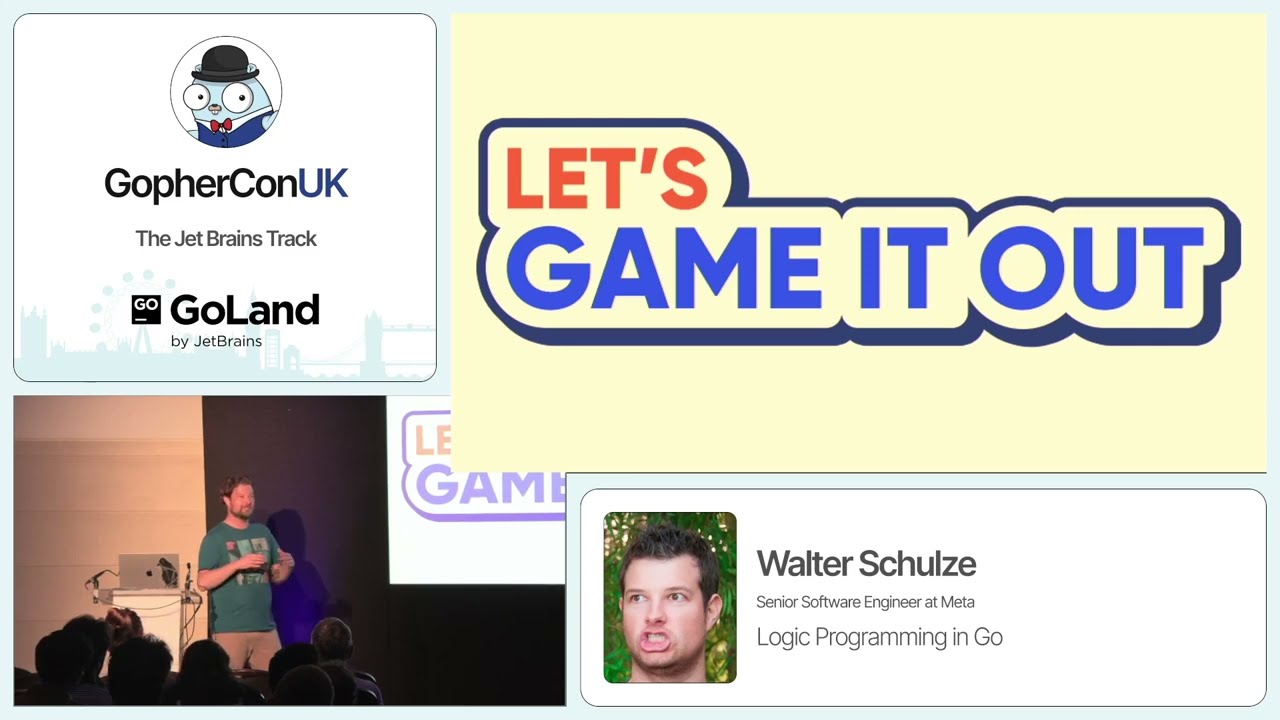gominikarnen is an implementation of miniKanren in Go.

miniKanren is an embedded Domain Specific Language for logic programming.
Currently there are 3 implementations included in this repository:
- gomini - the concurrent version that works on any Go data type that is a pointer
- micro - the minimal implementation based on the paper (only works on ast.SExpr)
- mini - extends micro with operators from the book The Reasoned Schemer (only works on ast.SExpr)
First install Go
And then run on the command line
$ go get github.com/awalterschulze/gominikanren
ConcatO is a goal that concats the first two input arguments into the third input argument.
In this example we use ConcatO to get all the combinations that can produce the linked list [a, b, c, d].
package main
import (
"context"
. "github.com/awalterschulze/gominikanren/gomini"
. "github.com/awalterschulze/gominikanren/gomini/concato"
)
type Pair struct {
Left *Node
Right *Node
}
func main() {
pairs := toStrings(RunTake(context.Background(), -1, NewState(), func(q *Pair) Goal {
return ExistO(func(x *Node) Goal {
return ExistO(func(y *Node) Goal {
return ConjO(
EqualO(&Pair{x, y}, q),
ConcatO(
x,
y,
NewNode("a", NewNode("b", NewNode("c", NewNode("d", nil)))),
),
)
})
})
}))
fmt.Println(pairs)
}
// Output:
// [
// {[], [a,b,c,d]},
// {[a,b,c,d], []},
// {[a,b,c], [d]},
// {[a,b], [c,d]},
// {[a], [b,c,d]},
// ]gominikanren includes the four logic operators:
-
$=$ => EqualO -
$\exists$ => ExistO -
$\land$ (and) => ConjO -
$\lor$ (or) => DisjO
The next two operators are implicit most programming languages:
-
$\forall$ => a function parameter -
$\in$ => providing a type
ConcatO was created using the mathematical formula:
This looks rather intimidating, but we can give these variables some better names:
Then we can use this to translate it to gominikanren:
type Node struct {
Value *string
Next *Node
}
func ConcatO(xs, ys, zs *Node) Goal {
return DisjO(
ConjO(
EqualO(xs, nil),
EqualO(ys, zs),
),
ExistO(func(head *string) Goal {
return ExistO(func(xtail *Node) Goal {
return ExistO(func(ztail *Node) Goal {
return ConjO(
EqualO(xs, &Node{head, xtail}),
EqualO(zs, &Node{head, ztail}),
ConcatO(xtail, ys, ztail),
)
})
})
}),
)
}AppendO is a goal that appends the first two input arguments into the third input argument.
In this example we use AppendO to get all the combinations that can produce the list (cake & ice d t).
package main
import (
"github.com/awalterschulze/gominikanren/sexpr/ast"
"github.com/awalterschulze/gominikanren/micro"
"github.com/awalterschulze/gominikanren/mini"
)
func main() {
states := micro.RunGoal(
-1,
micro.CallFresh(func(x *ast.SExpr) micro.Goal {
return micro.CallFresh(func(y *ast.SExpr) micro.Goal {
return micro.ConjunctionO(
// (== ,q (cons ,x ,y))
micro.EqualO(
ast.Cons(x, ast.Cons(y, nil)),
ast.NewVariable("q"),
),
// (appendo ,x ,y (cake & ice d t))
mini.AppendO(
x,
y,
ast.NewList(
ast.NewSymbol("cake"),
ast.NewSymbol("&"),
ast.NewSymbol("ice"),
ast.NewSymbol("d"),
ast.NewSymbol("t"),
),
),
)
})
}),
)
sexprs := micro.Reify("q", states)
fmt.Println(ast.NewList(sexprs...).String())
}
//Output:
//(
// (() (cake & ice d t))
// ((cake) (& ice d t))
// ((cake &) (ice d t))
// ((cake & ice) (d t))
// ((cake & ice d) (t))
// ((cake & ice d t) ())
//)If you are unfamiliar with miniKanren here is a great introduction video by Bodil Stokke:
If you like that, then the book, The Reasoned Schemer, explains logical programming in miniKanren by example.
If you want to delve even deeper, then this implementation is based on a very readable paper, µKanren: A Minimal Functional Core for Relational Programming, that explains the core algorithm of miniKanren.
